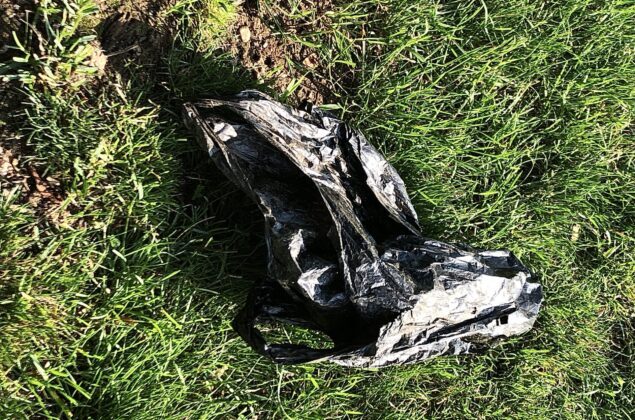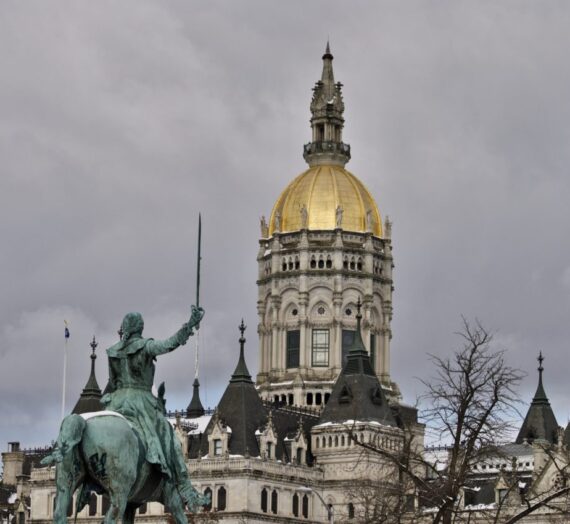On a recent morning walk commute, I noticed a plastic bag littering the sidewalk. Odd, I thought, since the sale of single-use plastic bags was banned in Connecticut in July 2021, two years ago.
Shortly after, I counted more, making for a total of five plastic bags in a 0.2 mile stretch. These were all on the ground, either outside of a section of park that’s bordered by thick, overgrown brush, or on the property of 25 Sigourney, the building once occupied by State of Connecticut offices, now owned by Spartan Towers, LLC (owner’s address is Michigan).
Once you start to notice some litter, you begin seeing it everywhere. I didn’t try to count all the plastic potato chip bags or other trash, though I paused to once again photograph the syringes atop the Sigourney Street bridge’s sidewalk that have been there for multiple weeks – at least the ones that didn’t wash away in the recent heavy rains – despite having reported these hazardous objects to Hartford 311 several times in the app and then through social media.
Although it is definitely less common for me to see plastic bags now than a few years ago, it actually is not weird that I would still see them. Plastic does not biodegrade. That’s what is obscene about single-use plastics. Something that is used by most for a very short time — mere minutes — stays here forever without becoming something useful. Plastic breaks apart. When an apple breaks down, it adds nourishment to the soil. Plastic adds toxins. Microplastics have been found in human breast milk, in human feces, in human blood. And in case anyone missed this day of science class, plastics are made from petrochemicals — fossil fuels.
If you think back to the time leading up to the single-use plastic bag ban, and in the few weeks of transition once it went into effect, you may recall some folks freaking out about how they could function without these bags. What I suggested at the time holds true, though a bit less so, today: take a walk and collect the loose plastic bags blowing around, tangled in trees, stuck in ponds. Use those.
We can dispose better of the resources we exploit, or we can pause and reconsider our rates of consumption.
Climate Possibilities is a new series about climate mitigation, along with resilience, resistance, and restoration. It’s about human habitat preservation. It’s about loving nature and planet Earth, and demanding the kind of change that gives future generations the opportunity for vibrant lives. Doomers will be eaten alive, figuratively. All photographs are taken in Hartford, Connecticut unless stated otherwise.


Linda Pagani
Sadly, a lot of small mom-and-pop establishments including food stores and restaurants in Hartford and other communities are still using plastic bags. It’s a conundrum, because those places need our support, but seemingly don’t care about the environment. Bringing our own bags is a partial solution, but it doesn’t stop these places from offering plastic bags to others. I don’t have confidence that speaking to the owners would effect change, but would love to be proved wrong.
Kerri Ana Provost
I’ve definitely still seen it here and there. One popular store/restaurant finally switched to paper bags recently. My guess is they had a huge supply of the plastic and wanted to use them. I understand that mindset: use what you have first.
But, a major difference I’ve noticed is that when I’m riding the bus, I very rarely see anyone using a plastic bag anymore. It was the norm, which I always thought weird because if you’re hauling groceries, you can carry more without worrying about a bag splitting open if you’re using a backpack or canvas bag. Most seem to favor the type of bags given at checkout at Target or Walmart which aren’t as durable as other materials, but so far I’ve only seen one of those types of bags turn up as litter. That seems like an improvement.
Richard
I love some of the carry bags that one can get at a grocery store. ShopRite sometimes has seasonal ones which are nice. I just bought a beautiful canvas bag with polka dots all over for my dress up bag. I use to hate it when plastic bags were caught in trees. You know I have been carrying my bags for years and now as an old bag I still do. My backpack for the heavies and one or two canvas bags and I am good to go. I brought home any plants I purchased this year in a Panera catering bag; it was going to be thrown out at work. A big no, no if I am around. Nice and big and fits a lot. Tim can fit nice size canvases in those Panera Bags. When a person walks or takes the bus one must know what type of bag is needed for what is going to be purchased. I think it adds to the excitement of going. One thing I noticed the paper bags being used now are not as good as the old types but at least they can be recycled or used for the bird cage. I love to see people now with their own bags entering or leaving the grocery store.
Kerri Ana Provost
I suspect that some of the resistence merchants had to the bag bill was because if people don’t bring their own, then it’s less limited how much Stuff a customer might buy on impulse — especially if they are only carting groceries to car and then carrying them a few steps from trunk of car inside house.
This is actually something I like about walking/taking bus to grocery store, along with the bag bill. I generally bring only enough bags for what I am planning to get. There may be a little wiggle room, but not for more than something small. And you’re completely right — the paper bags are usually not made so well anymore. I don’t want to double-bag them or pay for them, so unless I really need to, I keep it to only what fits in the bags I brought.
The “remember your bag” tip I see a lot is for people to leave their bags in the trunk of their car, but if you do not have a car, a substitute is to leave a few bags in your locker or desk at work.
Eric
Another marginal advantage for reusable bags at the market: it obviates the need for a hand basket, for the most part.
Small benefit, but handy when it’s busy and the store hasn’t any around.
Kerri Ana Provost
Yes!
If you bike, just use the panniers as the hand basket — that way you’ll know whether or not everything will fit, instead of guessing and then awkwardly jamming everything in/on the bike in the parking lot.
I *did* see one grocery store, in New Haven, that has signs saying people can’t use their bags/backpacks for this purpose, but that’s the only one so far I’ve seen. . . and it didn’t seem to be enforced.